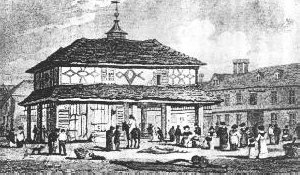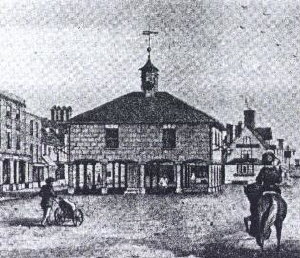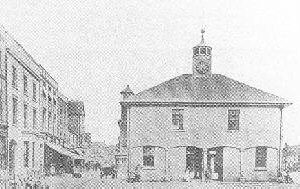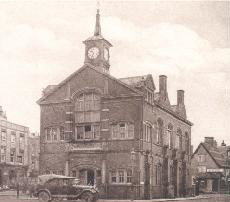Names such as, the Drapery, Cock Row, Butchers Row, Hog Fair and Sheep Row have been lost; but the Buttermarket and Cornmarket are still evident as is the Shambles, which is another name for Butcher's Row.
This Moot hall stood at the head of the Middle Row with the market cross and common well in between the two and probably looked much like this sketch.

The Early Market or Moot Hall
But this was certainly not the first Market Hall in Thame. Tuesday has been established as market day in Thame from 1183/4 and the first recorded market charter is 1215 so there would have been a need for a building to administer the market.
Merchant law was administered by merchants themselves before the bailiff, initially in a specially erected booth but later in the market hall. By 1221 the Bishop of Lincoln had encroached onto the highway and allowed buildings to be erected in the centre of the street.
The Market Hall of these times would have been an imposing building, prominent in the High Street and built to display the current building techniques. The building that fits all these requirements and dates from these times is the Bird Cage Inn.
The Elizabethan Moot Hall of 1509 had stood for a few hundred years and served its purpose well, but by the late 17th Century it was falling into disrepair.
A new Market Hall was built by the Earl of Abingdon in 1684. Like the previous one it was open underneath to provide shelter for the market traders as well as a meeting place, and it had a meeting hall above that was used as the main market court.

The 17th century Market Hall
In this market court the merchants would be charged by their fellow traders with breeches of the market rules. Here butchers would be charged with supplying putrid meat or selling meat before the allotted market time. Many traders were fined for fouling the gutters. There were no drains as we know them and everything would go down the gutter to Cuttle Brook and the river, so keeping the gutters clean was essential.
The measure for the sale of grain was the bushel which was a measurement of volume and not weight although the size would vary dependant on the grain. The market would provide a standard measure (presumably of basket-work) for use with the different grains.
Visitors, suspect of the townsmen, would regularly call for the measures to be checked.
By the 19th Century modification had been made to the hall; the bottom area had been enclosed and a spiral staircase had been added.
In April 1858 the Thame Gazette complained that the town lacked a hall suitable for lectures, concerts, religious and philanthropic meetings; and for these purposes a schoolroom had to be used.
The Market Hall, which was reached by a tortuous spiral staircase only held 80 and was often so crowded that there was scarcely room to stand.

The 19th century Market Hall
Soon after this, at a cost of £185, several rooms, including one used as warehouse, were merged into one creating sufficient space to accommodate 300 people.
However even this did not proove large enough and in 1887 it was felt that a new Town Hall would be a suitable edifice to commemorate the Golden Jubilee of Queen Victoria.
The existing building and site were purchased from Lord Abingdon for £100. The old hall was taken down and sold off for £55 5s 6d, (the old clock is now in Towersey Church).
The new brick building was designed by H.J. Tollit of Oxford and built by John Wells of Thame. The building cost £2,601 which was mainly raised by public subscriptions. However a deficit of £883 needed to be covered by a loan that was paid off from the rates.
Heavy rain spoiled the formal opening by Mrs. Reynolds on Easter Monday 1888, but did not mar the first use of the new chamber for a public luncheon to honour the opening.
After a fire in 1906 in the Council Chamber many alterations were made; but a proposal to provide a public convenience, made six years earlier, was deferred for another 25 years and these were only incorporated into the building in recent years.

The New Town Hall
The Town Hall has been little altered outwardly since it was built, although many citizens decry it as a Victorian red brick intrusion into a Georgian townscape. Certainly a building so out of keeping with the rest of the town architecture would never be permitted today.
In the 1930s it was described as "a building of Noah's Ark design, foisted on the town as a punishment for its apathy" and is a poor substitute for "their ancient and picturesque Market Hall".
The market continued to prosper but was blighted by continual bouts of disease. In the early 20th Century the Board of Agriculture decreed that the surface of the market place should be made impermeable to water, so that it could be effectively washed and disinfected and so in 1903 four areas of the High Street were paved, one for cattle on the northern side, one for sheep to the south and two for pigs in the centre.
Most of the paving has disappeared under tarmac but the pig paving still survives. At this time Thame market was seen as the third most important market in the county.
The functional control of the market had been transferred to the Market House in the Upper High Street and in the 1950s the animal market itself was moved to a larger site in North Street.
The retail market which had built up in Cornmarket moved to replace the Cattle Market in the Upper High Street.